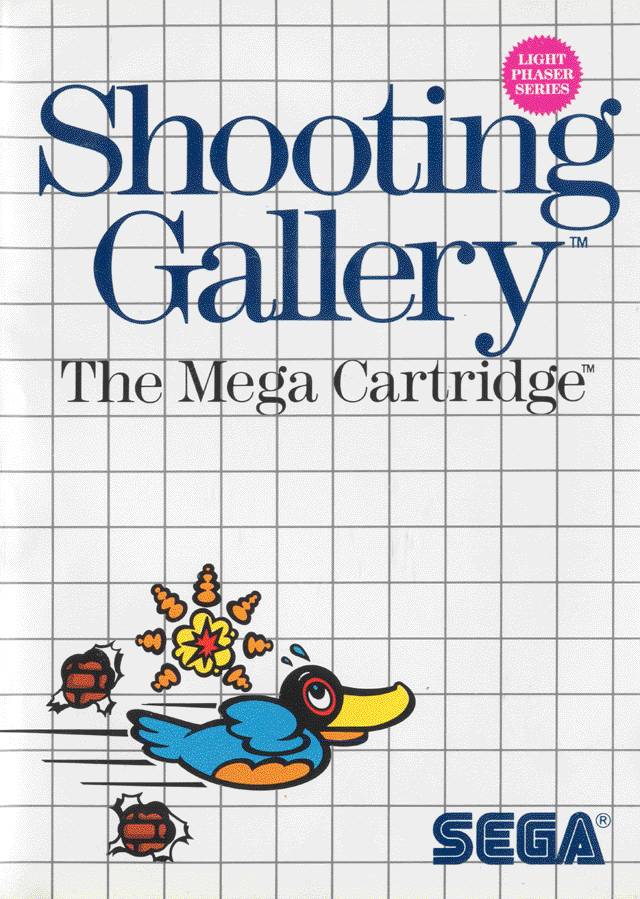
PLAYERS: 1
PUBLISHER/DEVELOPER: Sega
GENRE: Light Gun
RELEASE DATE: 03/87 – (US), 08/87 – (EU)
Shooting Gallery is exactly what its title says it is: a gallery of knickknacks paraded out for you to shoot with the Light Phaser. I imagine there were few games made for the Light Phaser as great as this one, though I do not believe the game is great. I just admire the purity of its purpose. The word “shooting” is in the title.
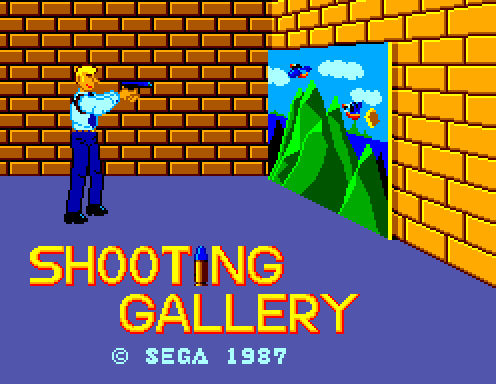
Shooting Gallery goes the extra mile to draw the player into its “world,” so to speak. Just look at the title screen: an off-duty cop or security guard stands with his gun drawn in front of a hastily painted mountain background (you’ll learn that the mountain background is for the duck stages). The yellow bricks surrounding the man are disconcerting – why yellow? – but he looks confident in his shooting abilities and that’s what matters. Why am I informing you of this? Because Sega deserves credit for injecting these details into their series of reflex exercises.
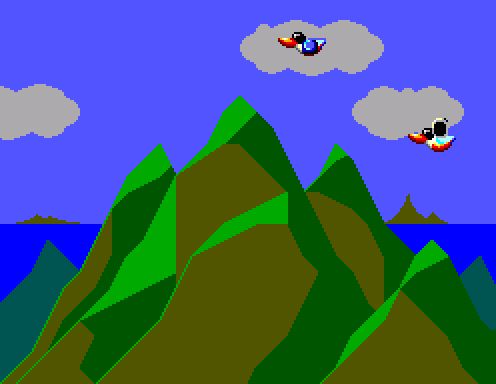
According to the Shooting Gallery manual, there are four different games with a total of six rounds. The names of the games are as follows: Just For the Birds, Aerial Attack, Twisting Tubes, and TV Terror. In Just For the Birds, you shoot ducks that fly around in unconventional patterns. Aerial Attack provides balloons and honest-to-goodness zeppelins. Twisting Tubes gives you balls weaving through knotted pipes. And TV Terror has you shooting spaceships and televisions that can only be shot when their shields are down. If this place existed in the real world, it would be the greatest shooting gallery known to man, particularly as you’re given unlimited rounds. Unlike many light gun games that purposefully limit your ammo to provide challenge, Shooting Gallery knows you’ll need as much ammo as possible to take out all the targets. Shoot to your heart’s content.
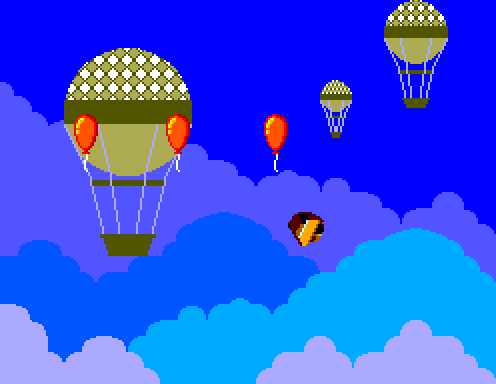
Despite the abundance of ammo, Shooting Gallery requires you to be a crack shot. In order to pass each round, you have to hit a certain number of targets, shown only at the end of each round. The deeper into the game’s twenty four rounds you go, the more targets provided, the faster they come, the more you’re required to shoot. There’s a lot of trial-and-error, a lot of sweat on the trigger. If you miss the round’s requirement, you’re back to stage one with the ducks, no second chances.
The game’s difficulty is unforgiving, particularly in Twisting Tubes and TV Terror. In Twisting Tubes, the balls move quickly through the mostly enclosed tubes, providing you with the slimmest of opportunities to shoot them. In TV Terror, you’re beholden to the spaceships and televisions dropping their shields – you shoot when the game says, not when you want to. These are exercises meant for children with lightning reflexes, reflexes that haven’t been tarnished by trauma, the daily toil, and other life-related happenings. The Light Phaser, surprisingly, could handle the stress, but I, as an increasingly tired individual, could not.
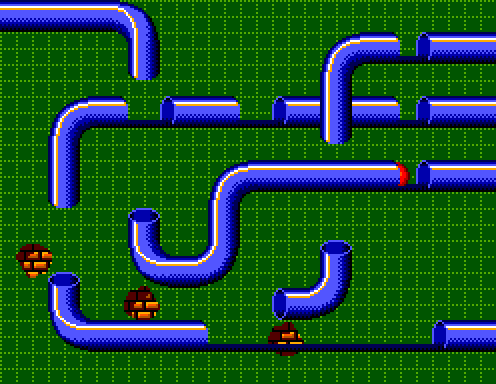
Ultimately, it’s the details of Shooting Gallery that elevate it above your typical light gun excursion. Each of the four environments have beautiful soft backgrounds unlike any I’ve seen on the Master System; as if a painter finished them moments before they were taken to the gallery. When you shoot at an object and miss, you chip the background, revealing the brick behind it. The chipped background is important. Sega is reminding you that the gallery is pure artifice. You’re not really in the sky shooting zeppelins or in space shooting floating televisions. I find this bold. After all, Shooting Gallery is a video game. The setting could be anywhere and the player wouldn’t blink an eye. “Shoot balls as they’re moving through tubes? Sure, why not?” But Shooting Gallery is intentionally fake. It takes place in the real world, or at least in a shooting gallery supposedly set in the real world, but all you see are the set pieces – and the occasional chip. This constant awareness of a false reality lends the game a depth that Sega likely didn’t intend. The falseness isn’t a commentary on anything, I’m sure, but it gave me something to ponder as I shot like mad at ducks and balloons.
B-

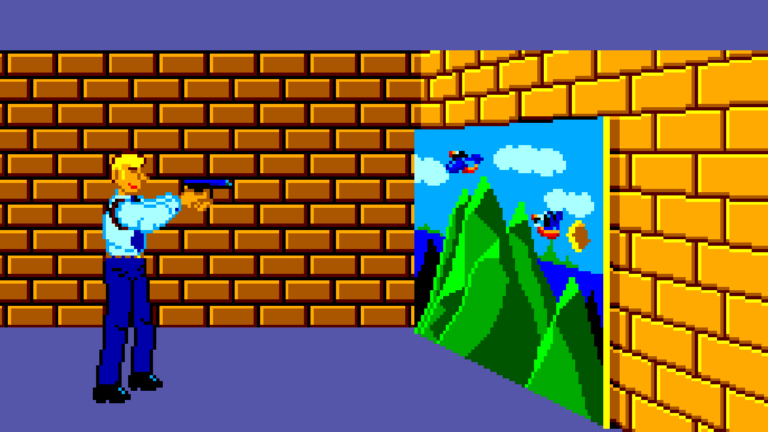
9 replies on “Shooting Gallery (Master System, 1987)”
B- I’ll take it, you hit on a lot of the great things about this game in your review. I’ve actually been waiting to post on this game for quite awile. This is my favorite light gun game on the SMS (Barely edging out Gangster Town). First off, I am a self admitted light gun game lover. There had never been a shooting game I could pass up playing. Yes even you Cabela deer hunting game sitting in a Walmart. (Because aren’t they always?) there a few different types of shooting games. This game falls squarely into my favorite type. The skill based shooting game. These usually are single shot affairs, not full auto weapons guns blazing like Operation Wolf. Usually accuracy is rewarded or required, and these games require pattern recognition and twitch reflexes and aiming. Basically as if you were at a gun range or a “Shooting Gallery”. This game is in the style of some of my top ever shooting games. Like Police Trainer, and Gun Panic. I love this game. I’ve played it for hours mastering the skill to beat it. And it’s all about accuracy and concentration and not rapid fire. In fact with rapid fire you won’t progress very far. I hear you on the pipes. Man those levels could be nerve wracking. But getting the shots in on those red balls as the appeared from gaps in the pipes and timing you trigger pulls with the ball speed to exactly nail them was super rewarding for me when you finally did it. And this game had a lot of other skill factors. Like to improve your accuracy and score, you could not only hit one target with one shot, but line up multiple targets with one shot. Like waiting until two balloons line up (Not easy and taking them out in one shot.) or getting two red balls at once as they cross paths from different pipes. Took real skill and that’s what I love about this game. That and the nice crisp graphics and backrounds. And the varying patterns of the targets on each stage. I felt real joy finally beating this game. This falls , for me anyway, into one of my favorite light gun games of all time, well at least my top 10. If you can play this with a real light gun on a CRT, I would highly reccomend it.
Also yes this game induced some nerve wracking sweatiness. And required intense concentration. I don’t know if I could handle it today. Although it is a good exersise at learning to calm your nerves, control your breathing and intensely focus on the task at hand. Having a perfect ru through of this game is an almost Zen like experience.
Good light gun games are almost like shoot-em-ups, in a way. To do well, you have to go outside of yourself and concentrate all your attention on the game. It’s a hard feeling to sum up, but it definitely applies to the technical skill needed to master Shooting Gallery. My hats off to you and your skills (which I’m assuming paid some sort of bills).
Ya it is like shoot em ups. Just a different set of skills you are flexing. Anyway I’m glad you got to write about this game, you never hear ANYBODY ever talk about it. I may one of the few who actually remember and like this game. You know it really makes me lament that HDTV has been the death of super accurate light gun games. It was a genre that I really loved. I have a Genesis, Saturn, and Dreamcast light gun that are basically useless. At least there are still the arcades.
I’m surprised that you haven’t kept an old CRT lying around. Please consider finding one in the future so your light gun games/skills don’t go to waste!
Also, with the exception of bigger names like Phantasy Star and Alex Kidd, I feel like many of these Master System games have been forgotten to time.
I just recently played this game and I was very surprised how good it was. The graphics and animation for an 8-bit light gun game was very good. Great review!
Check craigslist for crt TVs. People are giving these things away because they can’t leave them at the curb and thrift stores won’t take them. It’s worth it
I was reading the Kid Chamelon review and while looking at other games Mark Cerny did, Imfound out this was one of them. Mark Cerny made this game while working at Sega of Japan. Also he did Missile Defense 3D,
Mark Cerny’s track record seems a bit better than, say, David Crane’s.